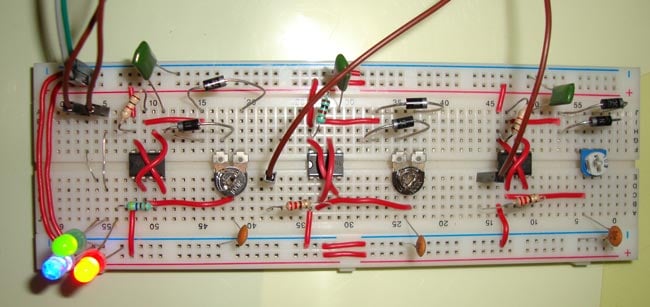
All the colors can be made from Red, Green and Blue color (RGB), these are the basic three colors from which we can generate any color. By varying the amount of these three colors, many colors can be generated. In case of light, we can produce any color of Light by using the three basic lights i.e. Red, Green & Blue and varying the intensity of these three light. So our basic task is to control the intensity of these three light.
We are building here a RGB bulb using Red, Green and Blue LEDs, we just need to add a mechanism to control the brightness or intensity of these light individually. To control the brightness, we are using PWM (Pulse width Modulation) method with 555 time IC. 555 timer IC can generate a pulse of variable width, and width of Pulse can control the Duty cycle. Duty cycle is nothing but the Ratio of High time to the total time.
Duty Cycle %= Turn ON time/ (Turn ON time + Turn OFF time) *100
Higher the duty cycle, higher the brightness of LED and lower the duty cycle Lower the Brightness. For example HIGH time is 8ms and LOW time is 2ms, then the duty cycle will be 80%, means the LED is oscillating between ON (8ms) and OFF (2ms). Now our eyes cannot see such high frequency oscillations and the Looks like LED is continuously ON at the brightness of 80%.
Go through this article PWM LED Dimmer Circuit, to properly understand the PWM concept.
Components
- 555 Timer IC - 3
- Resistor: 3 – 1k and 3 – 220 ohm
- Variable Resisotor: 3 – 10k or 100k
- Capacitor: Three – 0.01uF and Three - 0.1uF
- Diodes -6
- LEDs (RED,Green and Blue)
- Battery: 5-9v
Circuit Diagram and Explanation
We need to create three same blocks of circuits for three LEDs (RED, GREEN, BLUE). Here circuitry of one block is explained (Block of Blue LED), other two are the same.
Circuit is easy to understand, 555 timer is configured in Astable Mode, and we know that frequency and duty cycle are dependent upon the resistors between PIN 8 & 7 and PIN 7 and 6 and the timing capacitor C1.
- We have connected a variable resistor between PIN 6 and 7, with two diodes, so that the capacitor C1 is charged through the one part of the variable resistor and discharge using another part of the variable resistor.
- Like for example we have set the variable resistor (10k) knob like that resistor is divided between 7k and 3k, so the capacitor will be charged through the 7k resistor and discharged through 3k resistor.
- And as we know that output is High when capacitor in charging and Low when capacitor is discharging, so in this case HIGH time is greater than the LOW time and the duty cycle is also greater, so LED will be brighter.
- And if we rotate the knob in reverse direction, that will make the LED dimmer because the part of resistance through which the capacitor is charging, will be lesser than the part thought which, capacitor is discharging.
- So by rotating the knob of Potentiometer we can control the brightness of LED. Same circuitry is applied for other two LEDs (RED and GREEN).
Now we have control over the brightness of each LED, so we can put together the all three LEDs and produce any color by increasing or decreasing the brightness of any LED.
We have used a White Plastic Ball, and made a hole in it, then placed it over the LEDs, to use is like a Bulb. See the video for demonstration.
Comments
C1, C3 and C5 are ceramic
C1, C3 and C5 are ceramic capacitors, you can use any type of caps here either polarized or non polarized, they should work in this circuit.
about astable
Sir why we use in a astable mode , not in monostable mode







Very nice post, and I hope this wasn't from too many years ago, but in your diagram you have polarized caps for C1, C3, and C5. In the video I'm not sure of the caps you used, they don't look like Electrolytic caps. Can I and should I used polarized Electrolytic caps or are those some other sort of polarized caps? Or are non polarized caps ok to use?